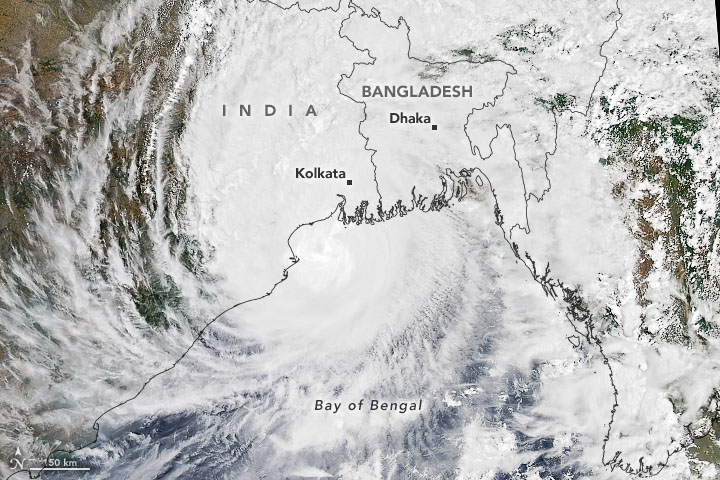Digha, India —(Map)
With heavy rains and strong winds, Cyclone Amphan hit the coast of India and Bangladesh on Wednesday afternoon, tearing up homes and other buildings, after forcing millions to evacuate.
The storm formed earlier in the week in the Bay of Bengal, the first “super cyclone” to form there since 1999. Though the storm dropped in speed, Cyclone Amphan still made landfall with a force equal to a Category 3 hurricane.
Cyclones
“Typhoon” and “hurricane” are names given to the same kind of storm, a cyclone. Whether a storm is called a cyclone, a hurricane, or a typhoon depends on where the storm starts. A cyclone with lower wind speeds is often called a “tropical storm”.

Source: NASA, EarthObservatory.)
With wind speeds of 105 miles per hour (170 kilometers per hour), Amphan tore through villages along the coast. Many of the people on the coast live in very simple houses, made with mud walls and simple roofs. The cyclone destroyed many of these houses, tearing the roofs off, and washing the walls away.
Amphan also blew down trees and electricity poles, taking out electricity, telephone, and internet lines in many places along its path.
The cyclone also caused huge and sudden rises in the sea level, known as “storm surges”. These surges were as high as 16 feet (5 meters) and pushed seawater in from the shore for miles, causing flooding, and ruining houses and crops along the way.
😕
This image has not been loaded because of your cookie choices. To view the content, you can accept 'Non-necessary' cookies.
With wind speeds of 105 miles per hour (170 kilometers per hour), Amphan tore through villages along the coast. Amphan also blew down trees and electricity poles, taking out electricity, telephone, and internet lines along its path. The photo above is in India.
In spite of Amphan’s power, the storm may not have been as deadly as people first feared. That’s mainly because governments were able to move many people to safety before the cyclone hit. Still, dozens of people have been reported killed, and the count is still rising.
Over 3 million people were evacuated in India and Bangladesh. The process was much more complicated than usual because of the coronavirus pandemic.
😕
This image has not been loaded because of your cookie choices. To view the content, you can accept 'Non-necessary' cookies.
Amphan was less deadly than expected mainly because governments were able to move many people to safety before the cyclone hit. Over 3 million people were evacuated in India and Bangladesh. Above, evacuation in Bangladesh.
The governments in both India and Bangladesh are using schools as temporary shelters. Several of the shelters were used before for quarantining patients with COVID-19. More shelters were needed than usual, because the governments are trying to fill the shelters only half full to allow social distancing.
Because of the coronavirus, many people weren’t eager to leave their homes. This was especially true in India. Part of the reason was fear of catching the disease, but it was also because many people have lost so much already during the country’s lockdown.
😕
This image has not been loaded because of your cookie choices. To view the content, you can accept 'Non-necessary' cookies.
The governments in both India and Bangladesh are using schools as temporary shelters. More shelters were needed than usual, because the governments are trying to fill the shelters only half full to allow social distancing. Above, a shelter in India.
One area of special concern in Bangladesh were camps of refugees, where 10 cases of the coronavirus were reported last week. These camps hold hundreds of thousands of people in crowded conditions with very simple shelters.
Luckily, the cyclone did not hit the camps. Because of the crowded conditions, it seemed likely that the coronavirus might spread quickly if large numbers of refugees had been forced to shelter together.
😕
This image has not been loaded because of your cookie choices. To view the content, you can accept 'Non-necessary' cookies.
Amphan may still have an effect, even on people who aren’t directly in its path. That’s because damage from the cyclone could interrupt the normal movement of supplies that the countries count on to fight the coronavirus. Above, trucks backed up in India.
Overall, Amphan may still have an effect, even on people who aren’t directly in its path. That’s because damage from the cyclone could interrupt the normal movement of supplies that the countries count on when fighting the coronavirus.
The cyclone comes at a particularly bad time for India, which saw its highest jump in the number of coronavirus cases on Wednesday.
😕
This map has not been loaded because of your cookie choices. To view the content, you can accept 'Non-necessary' cookies.
